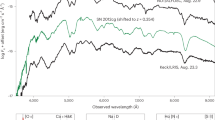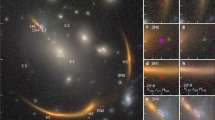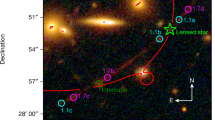Abstract
Gravitational microlensing1 is a powerful technique for measuring the mass of isolated and faint or non-luminous objects in the Milky Way2,3. In most cases, however, additional observations to the photometric light curve are required to measure accurately the mass of the microlens. Long-baseline optical/infrared interferometry provides a new and efficient way to deliver such independent constraints4,5,6,7, as demonstrated recently by first interferometric observations in microlensing event TCP J05074264+2447555 (‘Kojima-1’)8. Here we report real-time observations of gravitationally lensed arcs in rotation around a microlens, Gaia19bld9, made with the PIONIER instrument10 at the Very Large Telescope Interferometer. Our data allowed us to determine the angular separation and length of the arcs, as well as their rotation rate. Combining these measurements with ground-based photometric data enabled the determination of the microlens mass, M = 1.147 ± 0.029 M⊙, to a very high accuracy. We anticipate interferometric microlensing to play an important future role in the mass and distance determination of isolated stellar-mass black holes11,12,13 in the Galaxy, which cannot be addressed by any other technique.
This is a preview of subscription content, access via your institution
Access options
Access Nature and 54 other Nature Portfolio journals
Get Nature+, our best-value online-access subscription
$29.99 / 30 days
cancel any time
Subscribe to this journal
Receive 12 digital issues and online access to articles
$119.00 per year
only $9.92 per issue
Buy this article
- Purchase on Springer Link
- Instant access to full article PDF
Prices may be subject to local taxes which are calculated during checkout




Similar content being viewed by others
Data availability
The VLTI/PIONIER data (programme 0103.C-0522(A)) are available at ESO Science Archive Facility (http://archive.eso.org/scienceportal/home).
References
Paczyński, B. Gravitational microlensing by the Galactic halo. Astrophys. J. 304, 1–5 (1986).
Gould, A. Measuring the remnant mass function of the Galactic bulge. Astrophys. J. 535, 928–931 (1999).
An, J. H. et al. First microlens mass measurement: PLANET photometry of EROS BLG-2000-5. Astrophys. J. 572, 521–539 (2002).
Delplancke, F., Górski, K. M. & Richichi, A. Resolving gravitational microlensing events with long-baseline optical interferometry. Prospects for the ESO Very Large Telescope Interferometer. Astron. Astrophys. 375, 701–710 (2001).
Dalal, N. & Lane, B. F. Bringing closure to microlensing mass measurement. Astrophys. J. 589, 199–209 (2003).
Rattenbury, N. J. & Mao, S. Interferometric visibility and closure phase of microlensing events with finite source size. Mon. Not. R. Astron. Soc. 365, 792–800 (2006).
Cassan, A. & Ranc, C. Interferometric observation of microlensing events. Mon. Not. R. Astron. Soc. 458, 2074–2079 (2016).
Dong, S. et al. First resolution of microlensed images. Astrophys. J. 871, 70 (2019).
Rybicki, K. A. et al. Single lens mass measurement in the high magnification microlensing event Gaia19bld located in the Galactic Disk. Astron. Astrophys. (in the press).
Le Bouquin, J.-B. et al. PIONIER: a 4-telescope visitor instrument at VLTI. Astron. Astrophys. 535, A67 (2011).
Mao, S. et al. Optical Gravitational Lensing Experiment OGLE 1999 BUL 32: the longest ever microlensing event—evidence for a stellar mass black hole? Mon. Not. R. Astron. Soc. 329, 349–354 (2002).
Bennett, D. P. et al. Gravitational microlensing events due to stellar-mass black holes. Astrophys. J. 579, 639–659 (2002).
Wyrzykowski, Ł. & Mandel, I. Constraining the masses of microlensing black holes and the mass gap with Gaia DR2. Astron. Astrophys. 636, A20 (2020).
Einstein, A. Lens-like action of a star by the deviation of light in the gravitational field. Science 84, 506–507 (1936).
Gaudi, B. S. Microlensing surveys for exoplanets. Annu. Rev. Astron. Astrophys. 50, 411–453 (2012).
Calchi Novati, S. et al. Pathway to the Galactic distribution of planets: combined Spitzer and ground-based microlens parallax measurements of 21 single-lens events. Astrophys. J. 804, 20 (2015).
Bennett, D. P., Anderson, J., Bond, I. A., Udalski, A. & Gould, A. Identification of the OGLE-2003-BLG-235/MOA-2003-BLG-53 planetary host star. Astrophys. J. 647, L171–L174 (2006).
Fukui, A. et al. Kojima-1Lb is a mildly cold Neptune around the brightest microlensing host star. Astron. J. 158, 206 (2019).
Zang, W. et al. Spitzer + VLTI-GRAVITY measure the lens mass of a nearby microlensing event. Astrophys. J. 897, 180 (2020).
Baron, F., Monnier, J. D. & Kloppenborg, B. A novel image reconstruction software for optical/infrared interferometry. Proc. SPIE 7734, 77342I (2010).
Gould, A. P. Resolution of the MACHO-LMC-5 puzzle: the jerk-parallax microlens degeneracy. Astrophys. J. 606, 319–325 (2004).
Bachelet, E. et al. Spectroscopic follow-up of Gaia19bld. Astron. Astrophys. (in the press).
Clesse, S. & García-Bellido, J. Seven hints for primordial black hole dark matter. Phys. Dark Univ. 22, 137–146 (2018).
Mao, S. & Paczynski, B. Gravitational microlensing by double stars and planetary systems. Astrophys. J. Lett. 374, L37–L40 (1991).
Wyrzykowski, Ł. et al. Black hole, neutron star and white dwarf candidates from microlensing with OGLE-III. Mon. Not. R. Astron. Soc. 458, 3012–3026 (2016).
Cassan, A. et al. One or more bound planets per Milky Way star from microlensing observations. Nature 481, 167–169 (2012).
Suzuki, D. et al. Microlensing results challenge the core accretion runaway growth scenario for gas giants. Astrophys. J. Lett. 869, L34 (2018).
Sumi, T. et al. Unbound or distant planetary mass population detected by gravitational microlensing. Nature 473, 349–352 (2011).
Mróz, P. et al. No large population of unbound or wide-orbit Jupiter-mass planets. Nature 548, 183–186 (2017).
Cassan, A. Interferometric visibility of single-lens models: the thin-arcs approximation. Preprint at https://arxiv.org/abs/2109.11947.pdf (2021).
Foreman-Mackey, D., Hogg, D. W., Lang, D. & Goodman, J. emcee: the MCMC hammer. Publ. Astron. Soc. Pac. 125, 306–312 (2013).
Lynds, R. & Petrosian, V. Giant luminous arcs in galaxy clusters. Bull. Am. Astron. Soc. 18, 1014 (1986).
Soucail, G., Fort, B., Mellier, Y. & Picat, J. P. A blue ring-like structure in the centre of the A 370 cluster of galaxies. Astron. Astrophys. 72, L14–L16 (1987).
Gallenne, A. et al. Fundamental properties of red-clump stars from long-baseline H-band interferometry. Astron. Astrophys. 616, A68 (2018).
Schaefer, H. G., Cassan, A., Gallenne, A., Roettenbacher, R. M. & Schneider, J. Interferometry in the era of time-domain astronomy. Exp. Astron. 46, 421–431 (2018).
Wiktorowicz, G. et al. Populations of stellar-mass black holes from binary systems. Astrophys. J. 885, 1–21 (2019).
Zhu, W. et al. Toward a Galactic distribution of planets. I. Methodology and planet sensitivities of the 2015 high-cadence Spitzer microlens sample. Astron. J. 154, 210 (2017).
Acknowledgements
Our PIONIER observations were made under the ESO programme 0103.C-0522(A). We thank the teams who interrupted or postponed their visitor-mode observing runs to accommodate our time-critical observations, in particular K. Perraut (12 July data, GTO GRAVITY, P.I. García López) and S. Kraus (19 and 21 July data), as well as the observers (K. Tristam and A. Labdon) and the astronomers who assisted us in making these observations a success (C. Paladini, C. Hummel, L. Schmidtobreick, F. J. Selman and the ESO Paranal team at large). We also thank A. Mérand for his management of possible conflicts between ToO programmes. A.C. acknowledges the support of Sorbonne Université grants Émergence@Sorbonne-Universités 2016 and Émergence-UPMC 2012. C.R. acknowledges support from grants ANR-18-CE31-0002, NASA-80GSFC17M0002 and NASA-80NSSC18K0274. O.A. acknowledges funding from F.R.S.-FNRS. Ł.W. acknowledges support from the Polish NCN grants Harmonia no. 2018/30/M/ST9/00311 and Daina no. 2017/27/L/ST9/03221. K.A.R. acknowledges support from the Polish NCN grant Preludium no. 2017/25/N/ST9/01253. Y.T. acknowledges the support of DFG priority programme SPP 1992 ‘Exploring the Diversity of Extrasolar Planets’ (TS 356/3-1).
Author information
Authors and Affiliations
Contributions
A.C. led the analysis, contributed to the observations, performed the modelling of the PIONIER data and wrote the paper. C.R. contributed to the observations and to the modelling of PIONIER data. O.A. contributed to the observations and performed the reduction of the raw PIONIER data. Ł.W. identified Gaia19bld as a target for our programme and contributed to the observations. K.A.R. contributed to the observations and performed the modelling of the photometric data (published separately). É.B. performed the analysis of the spectroscopic data (published separately). J.-B.L.B. performed the non-parametric reconstruction of the microlensed images. M.H., R.S., J.S., Y.T., J.W. and O.W. participated in the scientific discussion. All authors discussed the results and commented on the manuscript.
Corresponding author
Ethics declarations
Competing interests
The authors declare no competing interests.
Additional information
Peer review information Nature Astronomy thanks the anonymous reviewers for their contribution to the peer review of this work
Publisher’s note Springer Nature remains neutral with regard to jurisdictional claims in published maps and institutional affiliations.
Extended data
Extended Data Fig. 1 Gaia19bld’s light curve near the magnification peak and PIONIER observations.
The black curve is the best-fit light curve to Gaia19bld’s photometric data (blue points with 1σ error bars), shown around the date of maximum brightness. The vertical arrows mark the dates of the Target of Opportunity trigger and of the three PIONIER epochs (12 July, 19 July and 21 July 2019). The photometric data and the light curve are in I-band magnitudes (left vertical axis), while PIONIER data are in H-band magnitudes (right vertical axis), obtained after correcting for differential extinction. The dashed horizontal line is the limiting PIONIER H-band magnitude for median atmospheric conditions.
Extended Data Fig. 2 Gaia19bld’s PIONIER closure phase measurements as a function of time.
Panels a and b display the measurements of closure phases (1−σ error bars) for 12 July 2019 (two observing sequences), while panels c and d correspond to 19 July (two observing sequences) and panel e to 21 July (one observing sequence). For each of the four possible triangles of telescopes Tijk (horizontal axis), the rainbow-colored dots with error bars mark the closure phase data split into the six effective wavelengths. The two sets of solid lines with small dots (in black and in gray) show the two possible microlens-source directions of motion (α and α + π), with the best-fit displayed in black.
Extended Data Fig. 3 Point-source model of the squared visibilities.
Panel a corresponds to 12 July (two observing sequences), panel b to 19 July (two observing sequences) and panel c to 21 July (one observing sequence). Data from 12 July were collected with medium VLTI baselines (longest baseline: 90m), while data from 19 and 21 July were obtained with large baselines (longest baseline: 128m and 126m respectively), which also set the maximum angular resolution of the observations. The leftmost plots (in gray shades) display the collected data in the Einstein u_Ev_E-plane (in \({\theta }_{E}^{-1}\) units), i.e. six VLTI baselines per observing sequence split into six effective wavelengths, marked by rainbow-colored dots. The point-source squared-visibility patterns are shown in gray scale ranging from ∣VE∣2 = 0 (black) to 1 (white). The inner dashed circle marks the typical angular resolution, and the outer circle twice the typical resolution. The plots in the middle show the data with their 1−σ error bars (in rainbow colors) as a function of B/λ (in \({\theta }_{E}^{-1}\) units), where B is the baseline length and λ the observing wavelength. The black lines correspond to the point-source model (shown only in the vicinity of the data points). The rightmost plots show the geometry of the microlensing event. The microlens (black cross, undetected by the interferometer) is set fixed in the center of the North-East reference frame (both axes are in θE units). The red and blue dots are respectively the major and minor point-like images of the source (which position is marked by a yellow dot), aligned with the microlens along the dotted line. The trajectory of the source relative to the microlens is indicated by the bold straight line with arrow, while the curved arrow indicates the direction of rotation of the arcs. This figure shows that a point-source model is not a valid approximation here.
Extended Data Fig. 4 Interferometric microlensing model and constraints on the microlens-source relative motion.
Panel a shows the model parameters for a single microlens L (black dot in the center), involving a point-source star (PSPL model) or an extended source (ESPL model). The (unseen) source S is the orange disk, of angular radius ρ in θE units (or the black dot in its center for a point source). The trajectory of the source with respect to the microlens is shown as the black thick arrow. It makes an angle \(\alpha ^{\prime}\) with the East-West horizontal axis, and \({u}_{0}^{\prime}\) (in θE units) is its signed impact parameter relative to the microlens. The major and minor arc-shaped images of the source are in red and blue respectively (or for a point source, the two black dots in their centers). The line joining the center of the two images makes an angle α1 with the East-West axis (with the major image up). For single epochs modelling, u1 is the microlens-source distance in θE units. As the source moves relative to the microlens along the black arrow, the images rotate around the microlens. Panel b displays the source at two consecutive epochs: S1 (orange filled disk) and S2 (orange circle), with corresponding images (major ‘+’ and minor ‘−’) labeled (I1+,I1−) and (I2+,I2−) respectively. Another trajectory is also shown, with the source at consecutive positions \({S}_{1}^{\prime}\) and \({S}_{2}^{\prime}\) and corresponding to images at (\({I}_{1+}^{\prime},{I}_{1-}^{\prime}\)) and (\({I}_{2+}^{\prime},{I}_{2-}^{\prime}\)). The similarity of the arcs for these two scenarii shows that the ratio ρ/u1 is measured by the interferometric squared visibilities, rather than the two parameters individually. Panels c and d show that when the major (red) and minor (blue) images are almost identical (which happens at high magnification), four directions of the microlens-source relative motion are possible (panel c). When three epochs are obtained, only two possibilities only remain (panel d), that can eventually be distinguished by the analysis of closure phases (if the asymmetry between the arcs produces effects above the noise).
Extended Data Fig. 5 Posterior probability densities of the best-fit parameters when fitting individual PIONIER epochs.
The figure displays the posterior distributions of model parameters α1 (direction of the line joining the center of the images with respect to the East-West axis), θE (angular Einstein ring radius, in mas) and η1 = ρ/u1 (ratio between the angular radius of the source and its distance from the microlens). Panel a corresponds to 12 July, panel b to 19 July and panel c to 21 July. The median values of the best-fit parameters are shown on top of the individual histograms with their 68 %-confidence intervals.
Extended Data Fig. 6 Posterior probability densities of the best-fit model parameters from fitting the three PIONIER epochs.
The figure displays the posterior distributions of model parameters assuming a straight-line trajectory for the source (relative to the microlens). θE is the angular Einstein ring radius (in mas), \({u}_{0}^{\prime}\) is the minimum impact parameter of the source trajectory relative to the microlens (in θE units), \({\eta }_{0}^{\prime}=\rho /{u}_{0}^{\prime}\) is the ratio between the angular radius of the source ρ and \({u}_{0}^{\prime}\), \({t}_{* }^{\prime}=\rho {t}_{E}^{\prime}\) is the product of ρ with tE, the time it takes the source to travel an angular distance θE, and \({t}_{0}^{\prime}\) is a time reference relative to JD − 2,458,681. The median values of the best-fit parameters are shown on top of the individual histograms with their 68 %-confidence intervals.
Extended Data Fig. 7 Relative microlens-source trajectory.
Panel a shows the source trajectory relative to the microlens in the North-East reference frame obtained by combining the PIONIER data and the ground-based light curve. The thick portion indicates the timespan covered by the PIONIER observations (12 to 21 July). Panel b displays the local direction of the same trajectory relative to the East-West axis (quantified by the source trajectory angle \(\alpha ^{\prime}\)) as a function of time (black line). The gray-shaded region encompasses the values of \(\alpha ^{\prime}\) allowed by assuming a straight line trajectory when fitting PIONIER data alone. t0,par is the reference date for parallax measurement from the light-curve modelling.
Supplementary information
Supplementary Information
Supplementary Figs. 1 and 2 and Tables 1–3.
Rights and permissions
About this article
Cite this article
Cassan, A., Ranc, C., Absil, O. et al. Microlensing mass measurement from images of rotating gravitational arcs. Nat Astron 6, 121–128 (2022). https://doi.org/10.1038/s41550-021-01514-w
Received:
Accepted:
Published:
Issue Date:
DOI: https://doi.org/10.1038/s41550-021-01514-w
This article is cited by
-
Essentials of Strong Gravitational Lensing
Space Science Reviews (2024)



